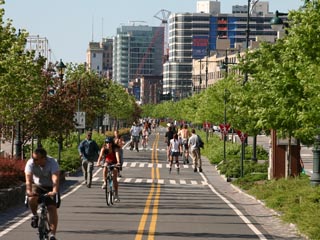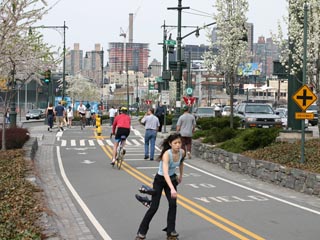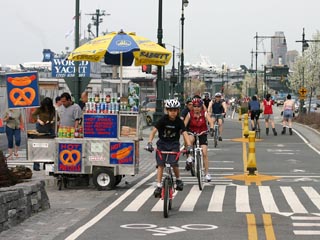Location:
Text from Hudson River Park Trust
In a city as dense and diverse as New York, Hudson River Park will be many things to many people. It will be a place where park-starved New Yorkers can soak in the sun or celebrate the seasons. A place where parents and teachers can help educate their children about the ecology and history of the Hudson. A place for running, playing, dancing, boating, or simply watching the boats sail by. A place for relaxing with your friends and neighbors.
A granite esplanade will span the entire five-mile park, bringing the public close to the water, while town docks, boat houses, a beach, and launches for canoes and kayaks will allow people to touch and even enter it. Back on land, undulating green lawns and groves of trees will separate walkers from the New York's finest bikeway. Ballfields will open for both children and adults.
But the best part of Hudson River Park will be the piers. Stretching up to 1,000 feet into the Hudson River, thirteen rebuilt piers will allow park visitors to leave the city behind them and experience the light, water and open space that are unique to the riverfront. Hudson River Park's piers will be islands of repose in the midst of our vibrant city.
Green shorelines, blue waters and open sky became the focus when planning for the park began over a decade ago. Since then, park planners have continued to work extensively with local communities, environmental organizations and businesses to create a living, breathing park for all visitors.
In 1998, the Hudson River Park Act officially created the park, reserving extensive portions of the waterfront exclusively for public recreation, and significantly limiting the types and locations of commercial activities. The Act also designated the river itself an estuarine sanctuary, and requires that every dollar made within the park goes right back into the park's construction, maintenance or operations.
The estimated park cost is $330 million. Both the State and City have already each committed $100 million to the project. The remainder will come from a combination of sources, including lease revenue and private fund-raising.
Much of the project's cost will be for infrastructure —rebuilding the pier structures, seawall, and the underground platforms which support the riverfront land. Those underground and underwater structures were built largely of wood in the 19th and early 20th centuries and must be replaced. The remaining capital expenses are for traditional park amenities like pavings, gardens, benches and lighting.
Hudson River Park's first section opened in Greenwich Village in September 1999, and further sections are under construction. The projected date of completion is 2005.
Events
Stroller Fitness Classes for Moms
The Stroller Strides classes in Hudson River Park are held every Monday and Wednesday from 10 am to 11 am. The class meets at the Runners Station, located one block North of the intersection of West and Canal Streets.
Community
More info and pictures of Hudson River Park at Wired New York Forum
See Also
Pictures of Hudson River Park

Bike path along Hudson waterfront, with Morton Square and Perry West. 12 June 2004.




